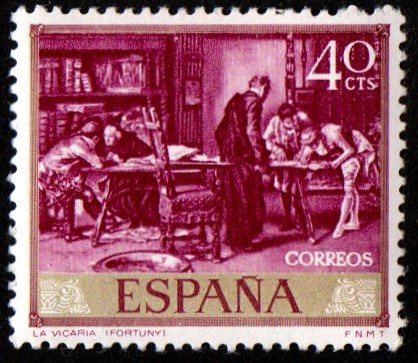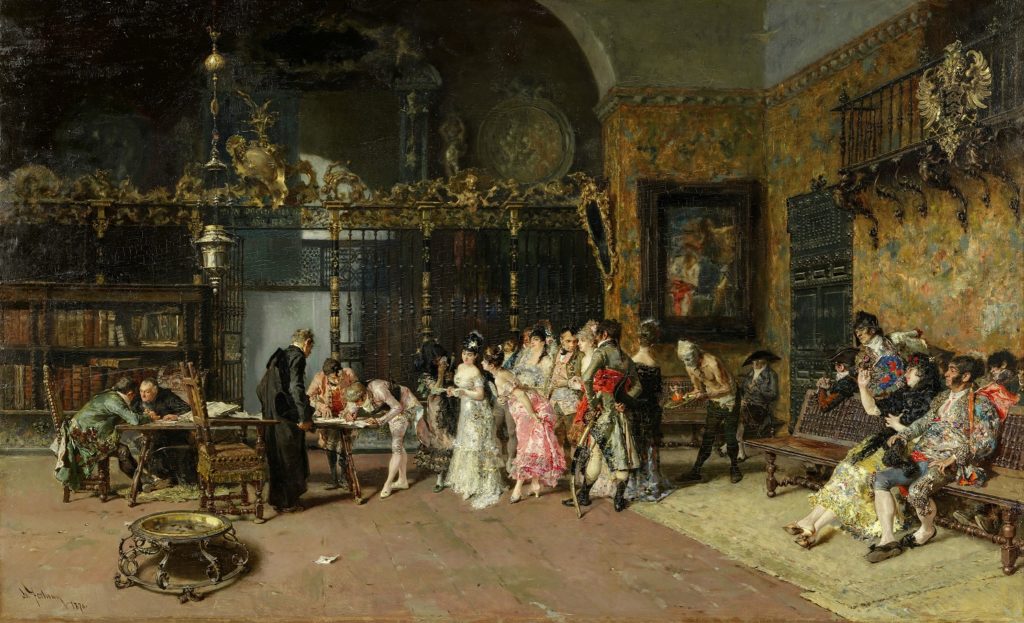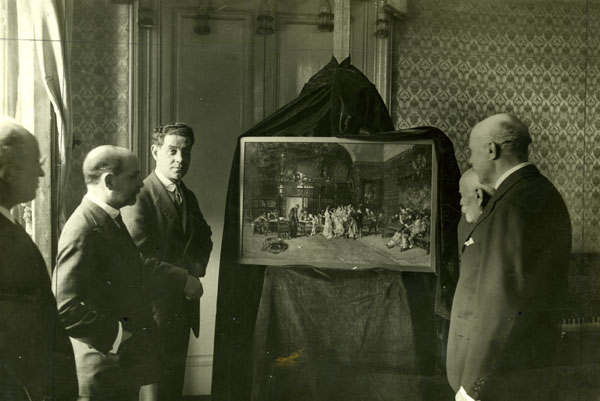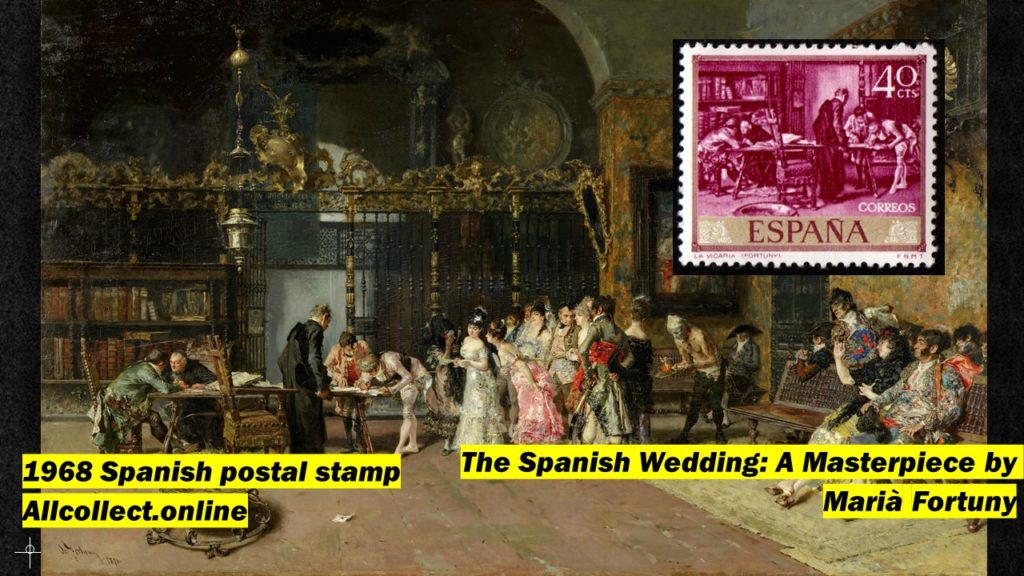In 1968 Spain issued a series of 10 stamps dedicated to paintings of Mariano Fortuny y Carbo (or Marià Fortuny in Catalan).
Each of the stamps deserves special attention. But we start with the first stamp in the series.

Marià Fortuny’s painting, “The Spanish Wedding” or “La Vicaría,” presented on a stamp in a fragment, is an important work of art from the 19th century. Created between 1868 and 1870, it an be seen at the Museu Nacional d’Art de Catalunya in Barcelona. The painting stands out for its incredible use of vibrant colors, sharp contrasts of light and shadow, and the exquisite skill evident in every brushstroke.
Born in Catalonia in 1838, Fortuny became renowned for his genre paintings, artworks that depict scenes from everyday life. His talents were evident early on, producing masterpieces at the age of 12. “The Spanish Wedding” is a prime example of genre art. The blending of historical and contemporary elements is a hallmark of such paintings.

Fortuny began “The Spanish Wedding” in Rome and completed it in Paris. His methodical approach to art involved detailed research, with numerous surviving sketches and watercolors shedding light on his creative process.
It’s believed that a visit to a Madrid parish church for his own wedding preparations inspired “The Spanish Wedding.” When unveiled in 1870, it was shown at Adolph Goupil’s gallery. Goupil, a significant art dealer of the era, arranged the painting’s sale to Adèle Cassin for an impressive 70,000 francs—a near-record price for artwork at the time. This sale solidified Fortuny’s international reputation, ensuring a high demand for his works throughout his career.
The painting remained privately owned until 1922 when fears of it being moved to America prompted its purchase by the Municipal Museum of Barcelona. Now, it graces the Museu Nacional d’Art de Catalunya.
As for the artwork itself, “The Spanish Wedding” portrays the signing of the wedding license ceremony. Central figures, the bride and groom, are surrounded by attendees. The viewer’s attention is drawn to the center where the groom signs the documents.

Fortuny’s expertise in capturing light and color is evident, drawing inspiration from the artist Goya. The contrasts, reminiscent of 17th-century Dutch masters, are pronounced. While the setting is contemporary to the 1870s, the attire borrows from the 18th century, mixing historical and modern elements—a common trait in genre paintings. The artwork is distinctly Spanish, from the peinetas on the women to the backdrop of a typical Spanish church.
“The Spanish Wedding” or “La Vicaría” by Marià Fortuny is a detailed depiction of a post-wedding scene, with a multitude of figures, each contributing to the narrative and ambiance of the painting.
The painting itself is small – only 60 by 93 cantimetres, but rich in details.

Here’s a closer look at the figures and their significance:
- Bride and Groom: Central to the painting, the newlyweds are the focal point of the scene. Their attire and posture denote the formality of the occasion. The groom is depicted in the act of signing the wedding documents, a gesture symbolic of commitment and legal union.
- The Priest: A crucial figure, the priest stands as a representative of the Church, sanctifying the marriage. His presence signifies the religious importance of matrimony in 19th-century Spain.
- Family and Friends: Surrounding the bride and groom are various attendees, presumably close family and friends. Their expressions range from joy to solemnity, capturing the range of emotions present at such an event. Their attire, particularly that of the women, is richly detailed, showcasing Fortuny’s skill in rendering intricate fabrics and accessories.
- Two Gentlemen at the End of the Table: These figures, observing the groom sign the documents, perhaps are witnesses to the marriage. In many wedding ceremonies, witnesses play a pivotal role, attesting to the union’s legitimacy.
- Older Couple on the Bench: Seated to the right, this pair could be parents or grandparents. Their more reserved demeanor contrasts with the younger attendees’ vibrancy, perhaps symbolizing the continuity of traditions and the passing of time.
- Background Figures: In the painting’s depths, various figures contribute to the setting’s depth and atmosphere. Their less defined forms and muted colors ensure the viewer’s attention remains primarily on the central figures.
Throughout the painting, each figure, whether prominently featured or subtly included, adds layers to the story. Fortuny’s meticulous attention to detail, from facial expressions to the intricacies of clothing, brings each character to life, inviting viewers to immerse themselves in the scene and perhaps imagine their own narratives for each individual.
Fortuny’s technique, termed “preciosismo,” involves intricate brushwork that merges to form a cohesive, radiant image from a distance. His style, influenced by the likes of Goya and Jean-Louis-Ernest Meissonier, subsequently influenced many artists, including Vincent van Gogh.
Despite his significant contribution to art, the rise of French Impressionism overshadowed genre artists like Fortuny. Yet, for those who delve into the annals of art history, his legacy remains undiminished.

